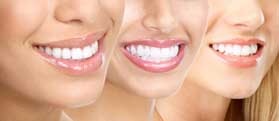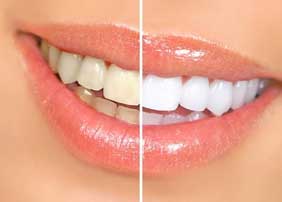
 A few Secrets to having “No Cavities!” at your next dental exam…
A few Secrets to having “No Cavities!” at your next dental exam…
1. Floss!
Simply put, debris gets trapped in between your teeth, and the longer it sits there, the more problems it can cause. Clear the debris by flossing after meals and before you go to bed.2. Floss properly!
I see too many people flossing incorrectly, here is a video for proper flossing technique.3.Use Fluoride.
Fluoride strengthens the enamel on your teeth. Check your toothpaste and mouthrinse and make sure that it has fluoride in it.4. Use an electric toothbrush.
Use an electric tooth brush such as the Sonicare at least twice a day. It vibrates at a very high frequency clearing debris from your teeth. Most people brush for too short a period of time, many electric toothbrushes will count the 2 minutes of recommended brush time.5.Go for routine oral hygiene visits.
The average person should get a professional dental cleaning twice a year. There are many areas of the mouth that are missed with routine home care – a professional cleaning will get to these areas. If you follow these steps strictly you will improve your oral hygiene and increase the likelihood of hearing the words “No Cavities!” at your next exam!]]> If you find your self doing the sniff test or constantly popping a piece of gum or a breath mint to hide your bad breath then you are probably one of the 80 million people that suffers from halitosis or chronic bad breath. There are many causes to bad breath but the biggies are:
There are many causes to bad breath but the biggies are:
1.Poor Oral Hygiene
If you haven’t seen the inside of a dental office in about two-three years, have no idea what floss is or how to use it, and your toothbrush is about as old as you are then you probably fall into this category. Brushing, flossing and regular dental visits are key to removing the plaque, bacteria and debris from your teeth. Your bad breath is being caused by the breakdown and decay of this debris and also from the wastes from the bacteria in your mouth. To prevent this make sure to always brush and floss after you eat and to visit your dentist every 6 months to remove any remaining plaque or calculus your brush and floss can’t reach.2.Dry mouth (xerostomia)
Dry mouth can be caused by many things, medical problems, medications you may be taking, mouth breathing, or radiation treatment. Saliva is a very important part of your mouths natural way to keep itself clean. Your saliva is constantly washing away food particles and bacteria in your mouth. If you have dry mouth this can allow the bacteria in your mouth to overgrow and food particles to remain and decay causing bad breath. To resolve this the first step is to find out what the cause of your dry mouth is. You should contact your dentist to come up with a good solution to keep your mouth clean.3.Diet and Nutrition
Another common cause of bad breath is due to your eating habits. Eating spicy foods, coffee, smoking, or eating onions and garlic can cause you to have bad breath for up to 72 hours after ingestion. Also, certain diets such as the Atkins or carb free diets can cause ketosis which gives your breath a sweet smell. Also, fasting and hunger can cause bad breath as well. The only solution to these problems is simply to eat a healthy well balanced diet and if you have an important event its probably a good idea to avoid onions and garlic for about a day or two beforehand. So most importantly, to keep your breath fresh and pleasant its important to brush and floss regularly, see your dentist every six months, keep hydrated, and maintain a healthy and well balanced diet.]]>  Have you noticed, now that you’re pregnant, you’re gums are red and inflamed, leading to gingivitis? During your pregnancy your body as you know is going through a lot of changes. Between the hormone surges, the morning sickness and the cravings you may feel like your body is out of your control. Because of all the changes you’ll be undergoing you have to be extra diligent about your oral health. Your teeth and gums are more susceptible to problems during this delicate period of your health.
Because of your overactive hormones your gums can become more reactive to plaque and bacteria on your teeth. This can make them more prone to gingivitis (inflammation and irritation of gums). It is not uncommon for pregnant women to get something called a pregnancy tumor on their gums. Normally they are painless, but can spontaneously bleed. These red or purple lesions are simply irritated and inflamed gum tissue that usually resolves after the baby is born.
Also, morning sickness can repeatedly expose your teeth to an acidic environment, leading to weakened tooth enamel and making you more susceptible to decay and erosion.
To prevent these problems you should continue to see your dentist regularly for cleaning appointments as well as practicing good home care. At home you should floss at least once a day and brush after every meal. If you are prone to morning sickness you may want to incorporate a fluoride rinse to your daily regimen. Some suggest that after vomiting you should rinse with a mixture of a teaspoon of baking soda dissolved in a cup of water, to neutralize the acid in your mouth prior to brushing.
Non-invasive procedures can be completed during your pregnancy, such as exams (without x-rays) and cleanings. If you have a dental emergency, which requires anesthesia to resolve, you should always contact your obstetrician first and get clearance for treatment.
Maintaining good oral health is important not only to mother but to baby as well. Recent studies have shown a link between low birth weight and pre-term babies and gingivitis. It is believed that bacteria from gingivitis can travel from your gums into your bloodstream. It can then travel to the uterus and cause an increased production of chemicals called prostaglandins which can induce premature labor. By following a good home care regimen and seeing your dentist regularly you can help maintain good oral health during and after your pregnancy.]]>
Have you noticed, now that you’re pregnant, you’re gums are red and inflamed, leading to gingivitis? During your pregnancy your body as you know is going through a lot of changes. Between the hormone surges, the morning sickness and the cravings you may feel like your body is out of your control. Because of all the changes you’ll be undergoing you have to be extra diligent about your oral health. Your teeth and gums are more susceptible to problems during this delicate period of your health.
Because of your overactive hormones your gums can become more reactive to plaque and bacteria on your teeth. This can make them more prone to gingivitis (inflammation and irritation of gums). It is not uncommon for pregnant women to get something called a pregnancy tumor on their gums. Normally they are painless, but can spontaneously bleed. These red or purple lesions are simply irritated and inflamed gum tissue that usually resolves after the baby is born.
Also, morning sickness can repeatedly expose your teeth to an acidic environment, leading to weakened tooth enamel and making you more susceptible to decay and erosion.
To prevent these problems you should continue to see your dentist regularly for cleaning appointments as well as practicing good home care. At home you should floss at least once a day and brush after every meal. If you are prone to morning sickness you may want to incorporate a fluoride rinse to your daily regimen. Some suggest that after vomiting you should rinse with a mixture of a teaspoon of baking soda dissolved in a cup of water, to neutralize the acid in your mouth prior to brushing.
Non-invasive procedures can be completed during your pregnancy, such as exams (without x-rays) and cleanings. If you have a dental emergency, which requires anesthesia to resolve, you should always contact your obstetrician first and get clearance for treatment.
Maintaining good oral health is important not only to mother but to baby as well. Recent studies have shown a link between low birth weight and pre-term babies and gingivitis. It is believed that bacteria from gingivitis can travel from your gums into your bloodstream. It can then travel to the uterus and cause an increased production of chemicals called prostaglandins which can induce premature labor. By following a good home care regimen and seeing your dentist regularly you can help maintain good oral health during and after your pregnancy.]]>

Myth #1: Whitening systems that use a laser are the best way to whiten teeth
Truth: This is a tricky subject. The term ‘laser’ is used for certain whitening systems. The ‘laser’ part of the In-Office whitening process is typically an ultraviolet light or a mercury metal halide light. These lights are a wavelenth that is in or near the visible light spectrum. To put it more simply, these lasers are more akin to heavy duty lightbulbs than the heavy duty lasers we have come to use in other aspects of dentistry. It is in my opinion that the term ‘laser’ although technically true, is used instead of UV light or mercury metal halide light because it sounds more impressive, high tech, and increases patient acceptibility of the procedure. The theory behind the ‘laser’ is that it activates the whitening gel and enhances the effects. However, many research articles show that the ‘laser’ works primarily by dehydrating the teeth whichmakes them appear whiter temporarily. And, as the teeth rehydrate, the shade evens out giving a result similar to other bleaching materials. Studies also have shown that this process can increase tooth sensitivity in the process and may actually decrease the whitening effect. I have used systems with and without the ‘laser’ and in my opinion I find that overall patient satisfaction is greater when we DO NOT use the ‘laser’.Myth #2: Certain name brand whitening systems are better than others
Truth: There are many whitening systems on the market and based on my experience in prescribing and using many of these products, I find that the major differences in whitening systems is the concentration of peroxide and whether the aformentioned ‘laser’ is used to enhance the effects. This is the breakdown of whitening materials: over-the-counter whitening systems cannot contain more than 10% carbamide peroxide (which is the active whitening agent) and In-Office whiteners can have a concentration from between 15-35%. The percentage of carbamide peroxide in In-Office whiteners depends on the company and the light used to enhance results is, as we mentioned before, up for debate. All whitening systems will result in whiter teeth (if you are a good candidate for teeth whitening). The difference is the length of time needed to achieve that result and the amount of sensitivity caused as a side effect. The higher the concentration of carbamide peroxide the faster you will see results.
Myth #3: In-Office teeth whitening takes 1 hour or less
Truth: I guess if you started the clock after…. #1. completing your medical history, #2. Examination of your teeth for restorations and cavities, #3. Polishing your teeth before placing whitening gel, #4. Placing the barriers on your gums and finally, #5. Applying the whitening gel… then maybe it would be an hour or less. Logistically, from the second you sit in the dental chair and begin the whitening process it takes about 2 hours from start to finish. Although, the actual amount of time that the gel is in contact with your teeth would be 45 minutes to an hour.
Myth #4: Your teeth will lighten 10 shades in one hour or less
Truth: This might be true if your teeth are the color mocha. In reality, the majority of peoples teeth are in the middle of the shade spectrum and do not see a drastic result such as 10 shades lighter. A realistic expectation would be 4-6 shades lighter for the average individual in one whitening sitting. 4-6 shades lighter when an individual starts in the middle of the shade spectrum will produce an outstanding, natural looking whitening result.
Myth #5: After I have my teeth whitened my teeth will be sensitive forever
Truth: The most commonly observed side effects of professionally applied peroxide products are temporary tooth sensitivity and the occasional irritation of gum tissues. Irritation of the gum tissue occurs when it is not correctly covered with a barrier material during the whitening process. Regarding the teeth, transient mild to moderate tooth sensitivity can occur in up to two-thirds of people during and after whitening treatment (which can last about 1-2 days). Sensitivity is generally related to the peroxide concentration of the material and the contact time (the stronger the concentration of peroxide and the longer applied, the more sensitivity). This is most likely the result of the easy passage of the peroxide through intact enamel and dentin to the nerve during a treatment interval. However, there have been no reported long-term adverse nerve problems when proper techniques are employed. The incidence and severity of tooth sensitivity may depend on the quality of the whitening material, the techniques used, and an individual’s response (genetics) to the whitening treatment methods and materials.
Myth #6: If I whiten my teeth too many times the enamel will become weaker
Truth:There have been reports of enamel damage to teeth, but apparently associated with the use of OTC whitening products. This damage may be related to the low pH (acidic) of the products and their overuse. Acids and tooth enamel do not mix well, often leading to tooth damage. A whitening gel should be as close to neutral on the pH scale as possible. A lot of science goes into the manufacturing of whitening products to control the pH and produce an effective gel, be very cautious of an unknown OTC whitening product. The take home point is, whether you are using OTC or professional grade whitening products, stick to whitening products of companies with good reputations and have professional supervision throughout the process.
Myth #7: After I whiten my teeth I will have to drink coffee and red wine through a straw otherwise my teeth will stain
Truth:You should stay away from dark beverages for the first two days after whitening because teeth are penetrable to stain. Your saliva has minerals in it that plug tubes leading from outside the tooth to the inside. The whitening process dissolves these plugs, leading to a tooth easily penetrable. Once the saliva reforms these plugs (~2 days) it is safe to drink dark beverages in moderation without consequence. As a side note, I myself am guilty of breaking the 2 day rule and have seen minimal stain relapse as a consequence.]]>
Myth #3: In-Office teeth whitening takes 1 hour or less
Truth: I guess if you started the clock after…. #1. completing your medical history, #2. Examination of your teeth for restorations and cavities, #3. Polishing your teeth before placing whitening gel, #4. Placing the barriers on your gums and finally, #5. Applying the whitening gel… then maybe it would be an hour or less. Logistically, from the second you sit in the dental chair and begin the whitening process it takes about 2 hours from start to finish. Although, the actual amount of time that the gel is in contact with your teeth would be 45 minutes to an hour.Myth #4: Your teeth will lighten 10 shades in one hour or less
Truth: This might be true if your teeth are the color mocha. In reality, the majority of peoples teeth are in the middle of the shade spectrum and do not see a drastic result such as 10 shades lighter. A realistic expectation would be 4-6 shades lighter for the average individual in one whitening sitting. 4-6 shades lighter when an individual starts in the middle of the shade spectrum will produce an outstanding, natural looking whitening result.Myth #5: After I have my teeth whitened my teeth will be sensitive forever
Truth: The most commonly observed side effects of professionally applied peroxide products are temporary tooth sensitivity and the occasional irritation of gum tissues. Irritation of the gum tissue occurs when it is not correctly covered with a barrier material during the whitening process. Regarding the teeth, transient mild to moderate tooth sensitivity can occur in up to two-thirds of people during and after whitening treatment (which can last about 1-2 days). Sensitivity is generally related to the peroxide concentration of the material and the contact time (the stronger the concentration of peroxide and the longer applied, the more sensitivity). This is most likely the result of the easy passage of the peroxide through intact enamel and dentin to the nerve during a treatment interval. However, there have been no reported long-term adverse nerve problems when proper techniques are employed. The incidence and severity of tooth sensitivity may depend on the quality of the whitening material, the techniques used, and an individual’s response (genetics) to the whitening treatment methods and materials.Myth #6: If I whiten my teeth too many times the enamel will become weaker
Truth:There have been reports of enamel damage to teeth, but apparently associated with the use of OTC whitening products. This damage may be related to the low pH (acidic) of the products and their overuse. Acids and tooth enamel do not mix well, often leading to tooth damage. A whitening gel should be as close to neutral on the pH scale as possible. A lot of science goes into the manufacturing of whitening products to control the pH and produce an effective gel, be very cautious of an unknown OTC whitening product. The take home point is, whether you are using OTC or professional grade whitening products, stick to whitening products of companies with good reputations and have professional supervision throughout the process.Myth #7: After I whiten my teeth I will have to drink coffee and red wine through a straw otherwise my teeth will stain
Truth:You should stay away from dark beverages for the first two days after whitening because teeth are penetrable to stain. Your saliva has minerals in it that plug tubes leading from outside the tooth to the inside. The whitening process dissolves these plugs, leading to a tooth easily penetrable. Once the saliva reforms these plugs (~2 days) it is safe to drink dark beverages in moderation without consequence. As a side note, I myself am guilty of breaking the 2 day rule and have seen minimal stain relapse as a consequence.]]>Frangella Dental
Offering advanced techniques in Cosmetic and General Dentistry in New York City.
200 W. 57th Street, Suite 1405
New York, NY 10019
(212) 245-2888
care@drfrangella.com
